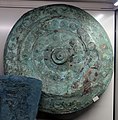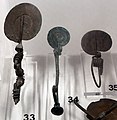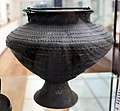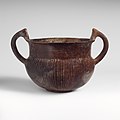
Villanovan culture
The Villanovan culture (c. 900–700 BC), regarded as the earliest phase of the Etruscan civilization,[1][2][3][4][5] was the earliest Iron Age culture of Italy. It directly followed the Bronze Age Proto-Villanovan culture which branched off from the Urnfield culture of Central Europe.[6] The name derives from the locality of Villanova, a fraction of the municipality of Castenaso in the Metropolitan City of Bologna where, between 1853 and 1855, Giovanni Gozzadini found the remains of a necropolis, bringing to light 193 tombs, of which there were 179 cremations and 14 inhumations.[7]
Main article: Etruscan civilizationGeographical range
Europe (Italy: Emilia-Romagna, Tuscany, Lazio, Campania)
Early Iron Age, Early phases of the Etruscan civilization
c. 900–700 BC
Orientalizing period (later 700–500 BC) of the Etruscan civilization
The Villanovans introduced iron-working to the Italian Peninsula. They practiced cremation and buried the ashes of their dead in pottery urns of distinctive double-cone shape.[8]
Housing[edit]
Buildings were rectangular in shape. The people lived in small huts, made of wattle and daub with wooden poles for support. Within the huts, cooking stands, utensils and charred animal bones give evidence about the family life of early inhabitants in Italy.[14] Some huts contained large pottery jars for food storage sunk into their floors. There was also a rock cut drain to channel rainwater to communal reservoirs.[13]
Villanovan settlements[edit]
Generally speaking, Villanovan settlements were centered in the Adriatic Etruria, in Emilia Romagna (in particular, in Bologna and in Verucchio, near Rimini), in Marche (Fermo), and in the Tyrrhenian Etruria, in Tuscany and Lazio. Further south, Villanovan cremation burials are to be found in Campania, at Capua, at the "princely tombs" of Pontecagnano near Salerno,[note 1] at Capo di Fiume, at Vallo di Diano and at Sala Consilina.
Small scattered Villanovan settlements have left few traces other than their more permanent burial sites, which were set somewhat apart from the settlements—largely because the settlement sites were built over in Etruscan times. Modern opinion generally follows Massimo Pallottino in regarding the Villanovan culture as ancestral to the Etruscan civilization.
Genetics[edit]
A genetic study published in Science in November 2019 examined the remains of a female from the Villanovan culture buried in Veio Grotta Gramiccia, Italy between ca. 900 BC and 800 BC. She carried the maternal haplogroup K1a4,[15] found all over Europe since Neolithic times,[16] and her autosomal DNA was a mixture of 72.9% Copper Age ancestry (EEF + WHG) and 27.1% Steppe-related ancestry.[17] There was evidence for consanguinity for this sample with another ancient sample (700 BC - 600 BC) from the Etruscan necropolis of La Mattonara near Civitavecchia, compatible with being the latter an offspring of third-degree relatives from the former.[18]

























